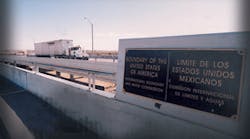Top federal transportation officials and high-profile trucking industry stakeholders offered opposing testimonies before the U.S. Senate Appropriations Committee that signaled deep divides in opinions of whether the DOT is up to the task of ensuring that long-haul Mexican trucks can operate safely and legally in the U.S.
At issue is a one-year pilot program that will authorize up to 100 Mexican trucking companies to transport international freight and not make domestic deliveries between U.S. cities.
Federal Motor Carrier Safety Administration (FMCSA) Administrator John Hill and Transportation Secretary Mary Peters said in a prepared joint statement that great progress has been made in ensuring that Mexican trucks are operating legally within “border commercial zones” since 1995.
FMCSA has deployed 125 inspectors and an additional 149 auditors and investigators along the southern border at all truck crossings. The States of Arizona, California, New Mexico and Texas have deployed an additional 349 inspectors.
“Ten years ago, the out-of-service rate for Mexican trucks was 59%,” according to the prepared remarks of Hill and Peters. “Since the increased enforcement that resulted from hiring the additional FMCSA and State staff, the rate dropped to 21% last year, which is comparable to the out-of-service rate we typically observe when we select U.S. trucks for inspection.”
Transportation Inspector General Calvin Scovel confirmed that FMCSA has improved border inspections by leaps and bounds.
“In 1998 we reported that FMCSA had only 13 Federal inspectors at the southern border,” according to the prepared remarks of Scovel. “By contrast…audit work underway now found 254 FMCSA enforcement personnel at the border.”
Scovel stressed that the pilot program will require that FMCSA and U.S. Customs and Border Protection work closely together.
“This could be problematic,” Scovel said. “Some 4.6 million commercial trucks entered the U.S. from Mexico in FY 2005.” The DOT estimates that about 1,000 Mexican-domiciled trucks will be involved in the pilot program.
Given that there are millions of U.S.-bound truck crossings from Mexico annually, tracking trucks in the pilot program presents a challenge of needle-in-a-haystack proportions without tight coordination with Customs, Scovel suggested.
The DOT emphasized that there is coordination between the two agencies. “FMCSA is working with Customs and Border Protection to have motor carrier safety integrated into the International Trade Data System, which is part of the Automated Commercial Environment development effort,” according to DOT. “When this initiative becomes fully operational, every Mexican company will have its authority and insurance checked and every Mexican driver will have his or her license checked each time the driver crosses the border, whether the vehicle is operating within the commercial zone or involved in long-haul transportation.”
But DOT’s optimistic appraisal of its own ability to enforce trucks operating under the pilot program was met with stiff criticism by Public Citizen, International Brotherhood of Teamsters and Owner-Operator Independent Drivers Assn. (OOIDA).
The three groups surmised that data collected from the pilot program would be skewed since FMCSA will likely select “cream of the crop” Mexican carriers to participate in the pilot, as opposed to a group that represents all Mexican-domiciled trucking companies.
“The pilot program will merely serve as a showpiece in order to permit the Secretary to proclaim victory and declare the entire southern border open to unfettered long-haul truck commerce before the end of 2008,” according to the prepared statement of Public Citizen president Joan Claybrook. “In order to properly serve the public and protect safety we must avoid this ‘mission accomplished’ mindset.”
Claybrook delivered scathing remarks against DOT that questioned the department’s competency, alluding to DOT’s failure to legally implement the 2003 hours-of-service rule. Public Citizen led the lawsuit that resulted in the 2003 rule being essentially declared illegal by the court.
“Let me begin by stating for the record that the Federal Motor Carrier Safety Adminstration…is just not up for the job,” according to Claybrook’s prepared statement. “The agency has never met any of its safety goals even after weakening them repeatedly these past five years, has had nearly every one of its safety regulations unanimously overturned by the courts, has ignored congressional direction to advance and improve safety, and completely ignores its statutory mandate to make safety its highest priority.”
Charlie Parfrey, president & COO of Parfrey Trucking spoke on behalf of OOIDA. “The safety concern also encompasses Mexico’s relatively lax regulation of its truck drivers,” according to Parfrey’s prepared remark. “Although Mexico does require that a truck driver obtain a Commercial Drivers License and undergo some form of physical examination, the Mexican requirements are much less stringent than those required by U.S. drivers. In addition, U.S. drivers also face strict, specific drug and alcohol testing and are subject to hours-of-service limitations…There is no way for federal or state enforcement officials to reasonably believe that a Mexican driver is drug-free, or know how many hours that driver has been working behind the wheel at the point they cross our border.”
And with Mexican truckers willing to work for comparatively low rates, “there will be a strong temptation by unscrupulous employers to capitalize on lower wage Mexican drivers and entice them into carrying domestic cargo in the United States,” according to the prepared statement of Teamsters president James Hoffa.
For additional coverage read Mexican trucking challenge mirrors HOS opposition and Peters says U.S.-Mexico truck trade about to improve.
To comment on this article, write to Terrence Nguyen at [email protected]




